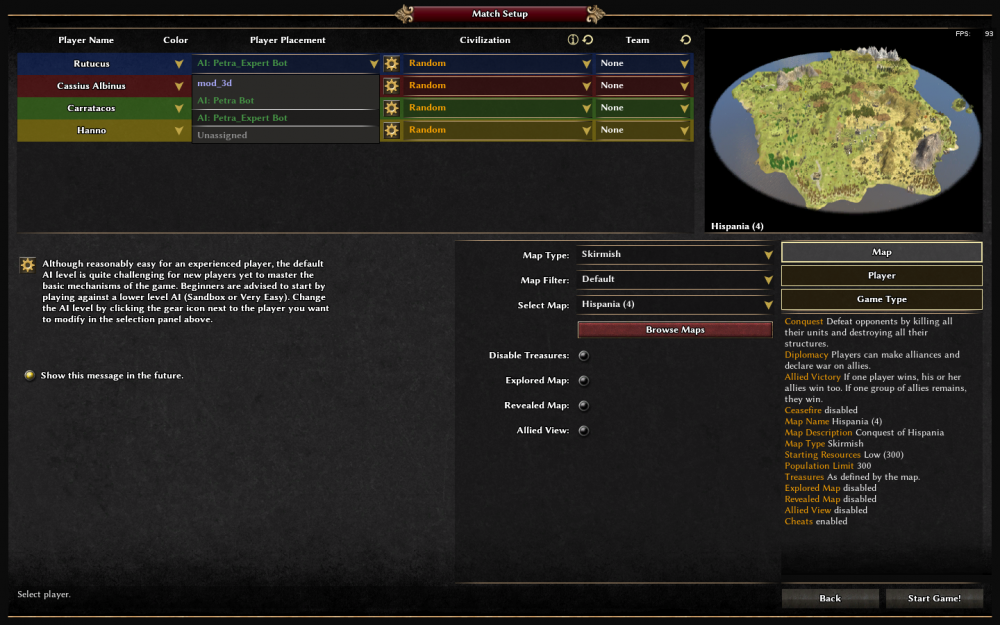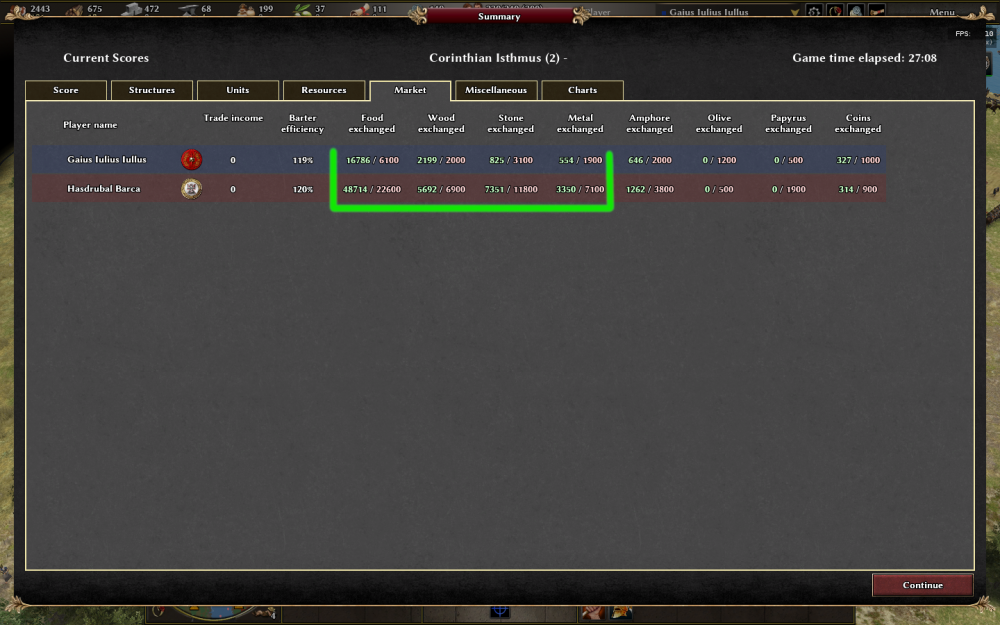Search the Community
Showing results for tags 'bot'.
-
Adds a more advanced bot(based on PETRA) to the game. UPDATE: Version 0.7.6 Fixed a bug when recruiting units on the very easy difficulty setting. UPDATE: Version 0.7.5 Bug fix UPDATE: Version 0.7.4 When retreating, support units will enter the garrison if there are relevant buildings nearby. After building a Temple, the bot will recruit 5 Healers and add them to rush groups, etc. Added individual queues for Siege units and Elephants. As soon as these units become available, they will be recruited with higher priority. Reduced conditions for moving to the next phase and building a second Civ Center. UPDATE: Version 0.7.3 Fixed a bug with recruiting Champions Fixed a bug with recruiting Support units, set the limit to 50. Added recruitment of Cavalry and Infantry at the start of the game for more defense against early rushes. UPDATE: Version 0.7.1 Disabled debugging. Fixed a bug when recruiting a large number of support units. The number would be around 60. UPDATE: Version 0.7.0 Support Units will react early and move a safe distance away from the opponent's units (Ranged and Melee). Ranged Units will react early and move a safe distance away from the opponent's Melee units. Previous versions bot_PETRA_Expert.zip
- 44 replies
-
- 11
-

-

-
Hi, When I set up the lobbybots, I get the following errors: 2025-07-23T15:14:25+0200 ERROR No appropriate login method. 2025-07-23T15:14:25+0200 ERROR Can't log in. Aborting reconnects. I’ve checked my ejabberd config and confirmed the user credentials are correct, but the bot still fails to log in. Could someone please advise how to fix this issue? Thanks in advance! Best regards, LogicXPlaysYT
- 9 replies
-
- 1
-

-
- error
- multiplayer lobby
-
(and 1 more)
Tagged with:
-
In the description of the sandbox mode (in the Russian version, at least) it was said that the bot does not expand the territory. But in my game, I think he built city centers.
-
I think, I'm getting really close to finalize the domain specific lanaguage (DSL) used in Hannibal's groups and want to ask for some feedback, because this what this bot is all about. The idea is only groups talk to the engine. Some unit should gather a field, there is a group for that. Want to build houses - launch a builder group. Need resources, give the supplier group some entity ids of trees, mines or whales. Groups are the building blocks of the behavior of Hannibal, everything else is low level or services. If something is going wrong a group is probably missing or not properly programmed. Actually you can think of Hannibal as a bot framework with groups as the user interface. Let's say you want an anarchy bot, but don't want to deal with map analysis or the 0AD bot API, all you need to do is fork Hannibal and define new groups with new behavior. How does it work? Well, technically the DSL works by chaining JavaScript methods. Here is a trivial example: array .sort() .filter(item => item > 5) .forEach(/* do stuff */);That works because both sort() and filter() return an array. Fortunately JavaScript's automatic semicolon inserter doesn't kick in. Hannibal's DSL looks similar, but it adds another level. Let's start with the most important group, the base of any village, the grain pickers. I'm going to challenge your imagination, but give it a try: Assume YOU are that little female unit contracted to do nothing but gathering food. Still here? Ok, what is your job description? Basically: Stay alive and gather food. What are your options to stay alive? Let's say, if you got hit seriously flee and search for shelter. If the attacker is gone try to heal. And to gather? Well, that's simple: Gather food and carry it to a dropsite. OK, may be I should order a field if there is none. And even a dropsite, if all others are to far away. You see a gather-food-unit only needs a very simple mind. That's the concept of Hannibal: Give units a simple job description so they never go idle and group similar jobs together. From there complex bot behavior will follow/emerge. I now hear objections: You can't win a game with female food gatherer only! That's right. And I must say I haven't seen attacking units so far with this concept. So here is what I'm going to implement: The job description of a military is actually close to the above, stay alive and do damage. If you are successful move forward otherwise move back to a more secure place like a fully garrisoned fortress of a tower triangle. Hannibal's job is to provide this information, the attacking unit's job is to use it wisely. Can you now imagine a horde of cavalry keeping the right distance avoiding suicide attacks, never going idle and heal if exhausted? Back to the DSL, a group's scripts are triggered by events only. There is a one time event when the group launches, another when Hannibal assigns an asset (read entity, e.g. unit, field, house, dropsite), when the group got attacked, an asset got destroyed or a timed event. Here is the list: launchassignattackdestroyintervalObviously launch is kinda initialization. The group declares what assets are needed and presumably orders the first one. This is the grain pickers launch script: function launch (w) { w.units = ["exclusive", "food.grain GATHEREDBY WITH costs.metal = 0, costs.stone = 0"]; w.field = ["exclusive", "food.grain PROVIDEDBY"]; w.dropsite = ["shared", "food ACCEPTEDBY"]; w.units.size = 5; w.field.size = 1; w.dropsite.size = 1; w.nounify("units", "field", "dropsite"); w.dropsite.on.request(); }The assets are defined using the internal query language, they all need a size and then the definition gets 'nounified'. All left is requesting a dropsite which sooner or later triggers the assign script. The DSL has kind of a grammar consisting of sentences, nouns, subjects, objects, verbs, attributes and modifiers. w.dropsite.on.request();Above is a sentence. JS experts see property chaining works too. 'w' is the world the language is defined in. Each group acts in its own world. 'w' is always the first parameter in script call. Whenever something is nounified it is available either as subject or object. Here is what in this sentence happens: w // each sentence starts with the world .dropsite // dropsite is picked as current object .on // the current object is picked as subject .request() // the current subject fires an action, amount defaults here to 1; // sentence doneSo, in plain English it means: Dear Hannibal, I desperately need a dropsite for food. As most maps have a civic centre as start up building this command is actually a no-brainer. Probably already the next tick calls assign. If Hannibal can't provide a dropsite the map is probably un-playabale, because of lack of resources or whatever. Now things get a bit more complicated, the group may get assigned a dropsite, a field or an unit, so a filter is needed. function assign (w, item) { w.objectify("item", item); // got dropsite, requests unit, exits w.dropsite.on .member(w.item) .units.do.request() .exit ; ...Here dropsite is first selected as object, then as subject and then a member check follows. If that check fails all the rest of the sentence is ignored. In case of success units is selected as subject (do) and a unit is requested. 'exit' means all the rest of the whole script is ignored, think of 'return' in a JS function. It should be clear what comes next - a sentence for a new unit: // keep requesting units until size is metw.units.on .member(w.item) .lt(w.units.count, w.units.size) .request();'lt' - less than - compares 'size' as defined in launch with the actual amount of units. You miss the field? // the first unit requests field, exitsw.units.on .member(w.item) .match(w.units.count, 1) .match(w.field.count, 0) .field.do.request() .exit;Still the units do not gather, the script makes sure through the order of requesting there is a dropsite and units and a field. // got the field foundation, all units repair, exitsw.field.on .member(w.item) .match(w.item.foundation) .units.do.repair(w.field) .exit;Here is another modifier 'match' just checking whether a attribute is true. There are two more sentences, the whole thing is currently here: https://github.com/agentx-cgn/Hannibal/blob/master/source/simulation/ai/hannibal/grp-harvester.js#L61 For sure this is just the beginning, beside grain-picker, miners, lumber jacks, builders more is needed to support a village or even launch an attack. For example there will be a scout group having an object called scanner which scans the terrain and Hannibal transforms this information into a potential field needed to tell attackers which region is safe or not, thus giving the direction of forward or back. If at this point you think - wait stop - I have some sentences in mind for another group, you're welcome. Please, let me know or even better paste them below. This is the purpose of Hannibal, it let you try out in a simple way how an AI can work. All you need to do is put yourself into the position of an 0AD unit and determine your options. That's it. I nearly spend a year getting this idea running and actually see now units building villages, powered by groups scripts. I hope, I could understandably layout the potential. Now, my target is to release a sandbox (no attacks) version within weeks, showcasing this concept. Follow this topic for breathtaking videos PS. Developers may have all alarm clocks ringing because of performance, but keep in mind the scripts are fired on events only, there are not that many groups needed and so far none took longer than a millisecond. PPS: Ok, another one. A unit of your group got killed, what's the sentence? function destroy (w, item) { w.objectify("item", item); // lost unit, request another w.units .member(w.item) .request() ;}
-
I've found random trigger maps are superior to manually designing maps for bot testing. I can easily change number of bots and civs from the commandline without editing XML files. But that's the random map part. With the trigger part I even managed to change the resources before bot initialization and force research of technologies at game start. So a bot can build fortresses right away from start instead of collecting all needed resources and raising a town first. I'm sure I'll detect more useful possibilities soon and add them to 'brainland_triggers.js' as from trigger map code the simulation is available and Hannibal's groups scripts will make it a good choice for smarter map natives. If interested grab the files from git: https://github.com/agentx-cgn/Hannibal/tree/master/maps/random
-
I've collected quite some papers about RTS bots. From time to time I'll present here either a recently published one or one otherwise interesting. Research on agents in RTS games is very active, because the time constraints and the broad range of needed AI technologies is challenging. Doesn't doing science by playing RTS games sounds like an acceptable job description? I'll start with the 100 page thesis BDI agents for Real Time Strategiy games It is about an 0AD bot written by Andrea Dallatana. Unfortunately he no longer works on the bot. He describes in detail the mechanics of his bot. One idea I especially like is the job market to avoid units standing around doing nothing. Here is the module structure of ABot: Currently discussed at HackerNews is A Survey of RTS Game AI Research and Competition in StarCraft (2013), 19 pages. The authors specifically analysed bot versus bot games and state: ... the top three ranked bots in the competition (Skynet, Aiur and UalbertaBot) do not change their strategy at all depending on their opponent. For example, the Skynet bot (both in 2011 and 2012), always uses the same opening (two gates), except when playing a Terran opponent, when it uses nony. This reflects the trend that the performance of bots is still more dependent on carefully handcrafted and non-adaptive behaviors, ... The paper includes and describes a long list of detected bot strategies. Might be interesting to some human 0AD players too. Very technical is Kiting in RTS Games Using Influence Maps. Kiting is a trick bots can do easier than humans, because the micro management is overwhelming. In short a unit does a ranged attack on another unit and flees out of the range of the attacked unit before it reacts. I'm eager to implement this in Hannibal. Have fun reading!
-
I'm opening a new topic since the API version 3 has now been committed. Kind of a conclusion on the past 2 weeks' work before I head back to school, and probably abandon developing 0 A.D. for a good 2/3 months. Warning: this is a huge wall of text, mainly intended for my own reading later, so that I may pick up where I left off without too much trouble . So basically I'm fairly happy of how much progress has been made on Aegis in these 2 weeks of holidays I got (on top of the work I did back then). Defense has been fixed to a fairly great extent, the attack has improved, the economy has learned how to deal with technology and phases without really losing much in terms of efficiency (there's room for improvement, though), and generally everything has been made more robust than it was before. There is however still a lot to do, as most players and myself can already tell. I would like it if we could release a "Hard" AI that did not cheat. Currently hard mode cheats by gathering 33% faster (and very hard 66%). In order to do this, many things to consider: First, the AI build order needs to be perfected. I've watched replays of mainly Quantumstate and Alpha123, but there is still work to be done, everything is not perfect. Furthermore the economy manager still isn't completely rational in the way it assigns workers, which makes the AI lose a few precious seconds now and the, but this is particularly problematic in the early game. Also, it doesn't trade. Secondly, the AI is still very hardcoded. I've switched most of the "time" checks to "number of workers" checks but this is far from enough. The AI is generally hardly aware of itself when it takes decision, thus leading to average decisions, and mostly to a lot of trouble with unexpected cases. In particular, raiding the AI early currently tends to cripple it, as it does not recover well enough, trying to start attacks instead of focusing on rebuilding an economy, things like that. Thirdly, building placement in general needs to be improved. the code for dropsite placement is in itself fairly efficient, and returns generally pretty good results. However, the code that decides when to build a dropsite is extremely inefficient. Placement of most other buildings is basically random with a few tweaks and doesn't really follow any particular logic, when it probably should. Third big issue: the defense system is still quite flawed, both from the "no sense of self" effect of the AI, which will make it defend useless things, defend in obviously losing battles, or not defend enough when it ought to, and the many flaws in the logic. It's basically very "instant" defense, it doesn't really consider what happened in the past or what might happen. Case in point: a tower on the border near an AI dropsite will basically make it get all its workers killed as it doesn't really notice. Fourth big issue(s): attack and unpredictability. The first subpoint is that the AI sucks at attacking. Basically it makes relatively balanced armies, but it sends them to the enemy and doesn't really consider how to use these units the most effectively, making its attack mostly useless against a skilled (micromanaging) player. Secondly, the AI is extremely predictable. It has only one real "strategy", if you can call it so, which is also extremely hardcoded and not at all enemy dependent. Work on that is less of a priority, of course. The AI should probably handle the above points first, and then we will be able to consider making it actually do interesting things. Finally, I'll post again the "to-do" list I had posted on the AI API version 3 topic back in early november, as most of the points are still valid -No real naval support. It can handle attack over water, in a basic way, but that's it (Update: that actually might have become slightly buggy) -No handling of multiple-island realms. For Aegis, its starting island is all there is on the map. -No handling of the cases where the AI runs out of resources to gather. It will start lagging and clogging the queue manager. Linked with the above points. -The defense system is really basic. It can't handle continuous frontier skirmishes, placement of defense buildings is not logical, no wall building, it's not reacting perfectly to attacks either. No sense of "this is a dangerous area, I should avoid going/collecting/building there". No support for building units that counter the enemy favorite units. So many other things... -No diplomacy support (see Fexor's post in the general development forum) -Economy is still perfectible: drop sites placement and building could be optimized, as could be building construction, or even Build Orders in general. There are some slightly insane behaviours here and then. Generally this is probably the area where the AIs hold up the best, particularly Aegis. (Update: see above.) -Very partial technology support. Aegis goes up in phases, but it's not flexible. The API support for tech may not be perfect either. (Update: actually, it now researches all techs, but chooses them randomly. So work needs to be done on that). -Partial attack system. It's OK at strategy, but bad at tactics and will generally attack inefficiently (though Aegis is better than qBot at that). -no LOS/scouting support. AIs see everything. (Update: this is actually linked to making the AI react naturally: even when cheating, it should be aware of its enemies and take decisions based on them) -optimization is far from perfect, though it's slowly getting better. Some possible improvements: hierarchical entity collection filtering, getting the AIs not to iterate over all units in a single turn once in a while but balance the load... (Update: probably better now, but there is still ton of room for improvements). A last word about something that is still bothering me: the queue manager. Currently it gives "accounts" to each queue which grow over time as the AI collects resources. It works fairly well, but it has a tendency to make the AI sit on resources, particularly when the gathering rates are low and the needs high. I think going for the most human approach here is what would work best, but I must say I actually have little idea of what the "human" approach is. Basically we might need the rest of the AIs to register what they will probably want to train/build in the next minutes for the future needs to be fairly stable (which will also help econ…). Then we need the AI to actually pass stuff, making sure it doesn't sit on tons of food just because the next item needs a little wood, and to do it with the maximal efficiency. I am not sure what the best system for that is, but I think the current queue system isn't quite perfect. Edit: moved to general forum.




